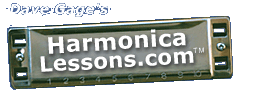Quote
Hi Fugz. A good book that will explain how to jam in first position and second position is Rock n' Blues Harmonica by Jon Gindick. http://www.harmonicastore.com/instruct_books.shtml
Yep, very good book. We also talk about 1st and 2nd position playing in the GENERAL OVERVIEW section and in the THEORY section.In order to use different scales (with any instrument) on a song, you need to know what chords are being played and then learn and use the appropriate scale for the chord change. This is called CHORDAL IMPROV and is very common with every instrument except harmonica.
For instance, on a "C" diatonic when you are playing in the key of "G" for 2nd position, the C scale now becomes the IV chord (sub-dominant) relative to the 2nd position key of "G". Therefore, you can play the 1st position C Major Scale over the IV chord in any song that has a IV chord in it when it occurs.
If you leave out the hole 5 draw (the 4th degree of the scale) and the hole 7 draw (the 7th degree of the scale), you are now officially playing a C Major Penatonic scale with works great on any C Major chord in any style of music. This scale can be played in 3 different octaves on a diatonic.
This approach I am describing for diatonic is call TARGET SCALES which is the big brother to the TARGET NOTE system found on the BASIC BLUES IMPROV page. A full advanced study of Target Scales is planned for the site, but I have about 12 bigger projects to get to first.
Play on,
(Dave, signed in as. . .)
Webmaster
